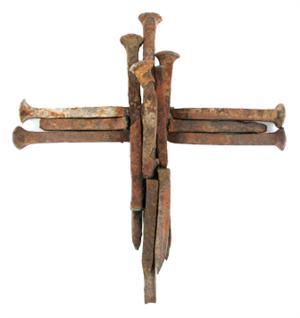| Complexity level: | 8 |
| Project cost ($): | 50 |
| Time required: | 1 hour to prepare, 2 days for the science project experiment |
| Material availability: | For this science project, you will need metal sheets, and these will have to be cut into small squares at a workshop or in your laboratory. |
| Safety concerns: | Basic safety requirements |
Hypothesis
Aluminum is the most resistant to corrosion.
Overview
Corrosion
Corrosion is essentially the oxidization of metal that occurs when water and oxygen are present. It is also known as rust in the case of iron. The corrosion of metal happens when they are placed in an environment where they become chemically unstable.
Copper, gold, platinum and silver are among the few metals that can be found in nature in their purest form. Most other metals like iron are found in the form of ore and need to be processed in order to extract the metal. These metals are unstable at room temperature. Some metals will form a natural coating on their outer surface to slow down the process of corrosion.
Scientific Terms
Materials
The materials required for the science fair project experiment:
- 3 copper sheets (cut to 1cm x 1cm)
- 3 aluminum sheets (cut to 1cm x1cm)
- 3 iron sheets (cut to 1cm x1cm)
- 3 zinc sheets (cut to 1cm x1cm)
- 12 beakers
- 1200ml of tap water
- 1200ml of salt water (100 gram of salt in 1200ml water)
- 1200ml of lime juice mixed with water (200ml lime and 1000ml water)
- 1 measuring cylinder
- 1 piece of cloth
- 1 bottle of alcohol
- 1 pair of scissors
- 1 ruler
- 1 black marker pen
Procedure
1. For this science fair project, the independent variable is the type of metal and the solution the metal is immersed in. The dependent variable is the appearance of rust or corrosion on the metal sheets over time. This is determined by observing the surface of the metal after 2 day. The constants (control variables) are the size of the metal sheet, the amount of solution used and the length of time the rust is allowed to set in the metal sheets.
2. The science experiment is started by cutting the 4 types of metal sheets into 3 pieces each 1cm x 1cm in size. . The surface of the cut pieces are then cleaned with the cloth and alcohol.
3. The 12 beakers are filled with 300ml of tap water, salt water or lime juice, 4 beakers for each type of solution. The solution used is marked outside the beaker as “tap water”, “salt water” or “lime juice”.
4. The small metal pieces are placed inside the beakers. The 3 copper pieces will be placed in one beaker of tap water, one beaker of salt water and one beaker of lime juice. The beakers will be labeled “copper” on the outside. Similarly, the aluminum, iron and zinc pieces are placed in the beakers containing different solutions and labeled accordingly.
5. The beakers are placed aside for the next 2 days and after that observed for corrosion. The observations are recorded in the table below.
Results
It was observed that the aluminum sheet was the most resistant to rust, out of the 4 types of metals used in this experiment.
| Metal | Tap water | Salt water | Lime juice |
| Copper | X | X | X |
| Aluminum | Y | Y | Y |
| Iron | X | X | X |
| Zinc | X | X | X |
Y - metal plate is ok, no corrosion
X – Corrosion has started to appear on the metal plate
Conclusion
Our hypothesis has been proven to be true. Between aluminum, copper, iron and zinc, aluminum is the most corrosion resistant metal. Most metals already have some form of natural or factory-applied coating on their surfaces to prevent or delay corrosion from taking place. However, when the metal sheets are cut into smaller pieces, the surface will become exposed on the sides that are cut. This is where most of the corrosion begins.
Corrosion will cause metal surfaces to get wear out and finally disintegrate. Most metals will form a natural protective coating to prevent or delay the onset of corrosion. However, metals can also be protected from corrosion by painting the surfaces or plating them. Chroming is one of the common industrial plating practices used to protect metal surfaces.
Also consider
What would happen if the science project experiment is done using other metals like tin, lead, magnesium or nickel?
Try testing using different acidic and alkaline solutions to induce corrosion in the metal samples.
References
Corrosion - http://en.wikipedia.org/wiki/Corrosion
Corrosion of metals - http://corrosion-doctors.org/MatSelect/corrmetals.htm
Why metals corrode? - http://corrosion.ksc.nasa.gov/corr_metal.htm

